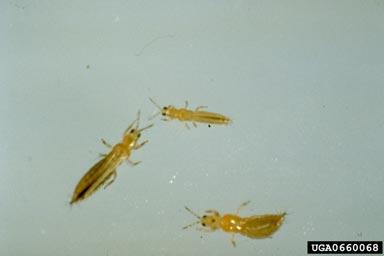Biology
Flower thrips (Frankliniella spp.) are tiny insects that feed on strawberry leaves, flowers, pollen and fruit. In addition to strawberries, they feed on a variety of other cultivated plants and weeds. Some flower thrips feed on twospotted spider mite eggs so low levels of flower thrips can be beneficial. To the naked eye, flower thrips look like elongated yellow or brown specks, about a millimeter long, that run rapidly when disturbed. Examination with a hand lens or microscope reveals the adult flower thrips to have two pairs of feathery wings.
Adult female thrips lay their eggs into the leaf of a host plant. The tiny (< 1mm) yellow or white larvae hatch 2-14 days later. Availability of pollen and warm temperatures greatly facilitate larval development which can be completed in as little as 3-5 days. Once mature, larvae spend a pre-pupal and pupal stage in the soil before returning to the plant to feed and reproduce as adults.
Damage in Strawberry
Flower thrips' tiny mouthparts pierce and suck plant juices from the outer layer of plant tissue. This feeding does not seriously damage strawberry leaves, but thrips feeding can cause misshapen blossoms and bronzing of the fruit near the leaf cap. Such feeding damage is rare in North Carolina, and when it does occur, usually happens late in the season.
Thrips feeding has not been shown to impact fruit set, and thrips feeding does not cause deformed fruit.
Sampling and Thresholds
Strawberry blossoms can be held over a piece of white paper and beat against it so that thrips fall onto the paper. Note that even adult thrips are very small, so a handlens may be useful for distinguishing them from other arthropods. Treatment thresholds for North Carolina have not been established, but work in California indicates the insecticide treatment should be considered only after populations exceed 10 thrips per blossom.
Management Options
Conventional
Conventional foliar insecticides are available for control of flower thrips. Refer to the North Carolina Agricultural Chemicals Manual for materials recommended for use in North Carolina and the Southern Region Small Fruit Consortium Strawberry IPM Guide for regional recommendations.
Organic
OMRI approved foliar materials are available for control of flower thrips. Refer to the North Carolina Agricultural Chemicals Manual for materials recommended in North Carolina and the Southern Region Small Fruit Consortium Strawberry IPM Guide for regional recommendations.
Biological
Minute pirate bugs, such as the insidious flower bug (Orius insidiosus), feed readily on flower thrips. These insects occur naturally in North Carolina, and purchasing additional bugs for release is unlikely to be cost effective. Some predatory mites are available for release against thrips (Amblyseius swirskii), but these mites have not been widely tested in strawberries.
More Information
Western Flower Thrips - UC IPM Online
Flower Thrips in Ornamentals - NC State Extension Entomology Insect Notes
North Carolina Agricultural Chemicals Manual
Strawberry IPM Guide - Southern Region Small Fruit Consortium
Publication date: May 15, 2014
N.C. Cooperative Extension prohibits discrimination and harassment regardless of age, color, disability, family and marital status, gender identity, national origin, political beliefs, race, religion, sex (including pregnancy), sexual orientation and veteran status.

